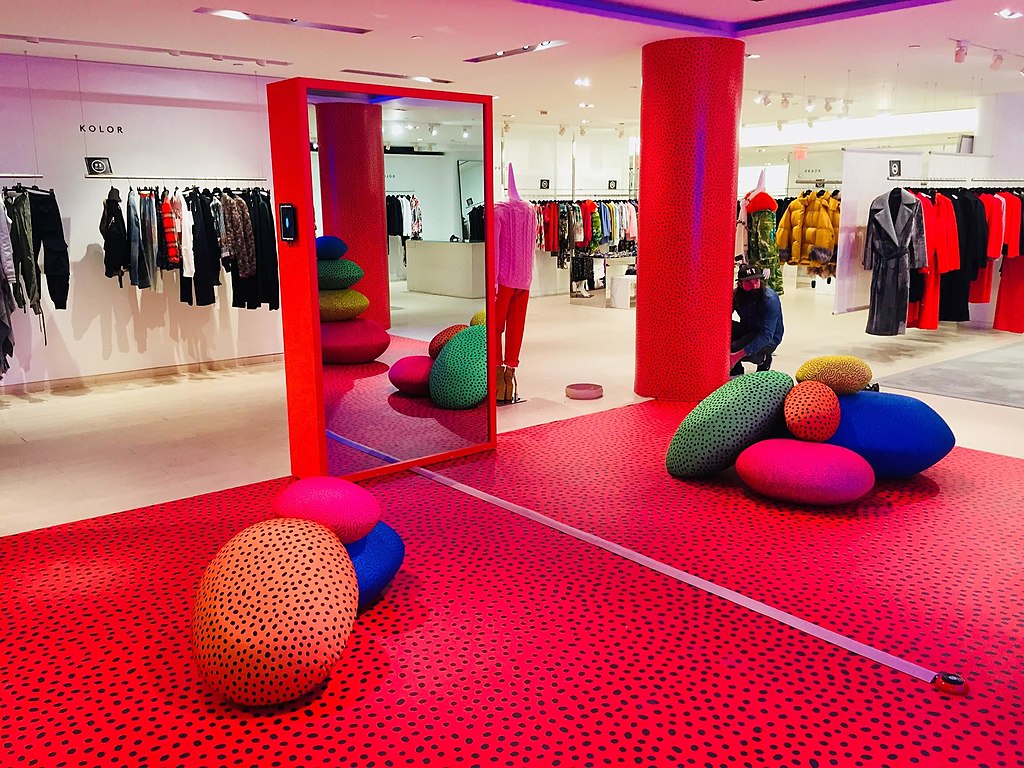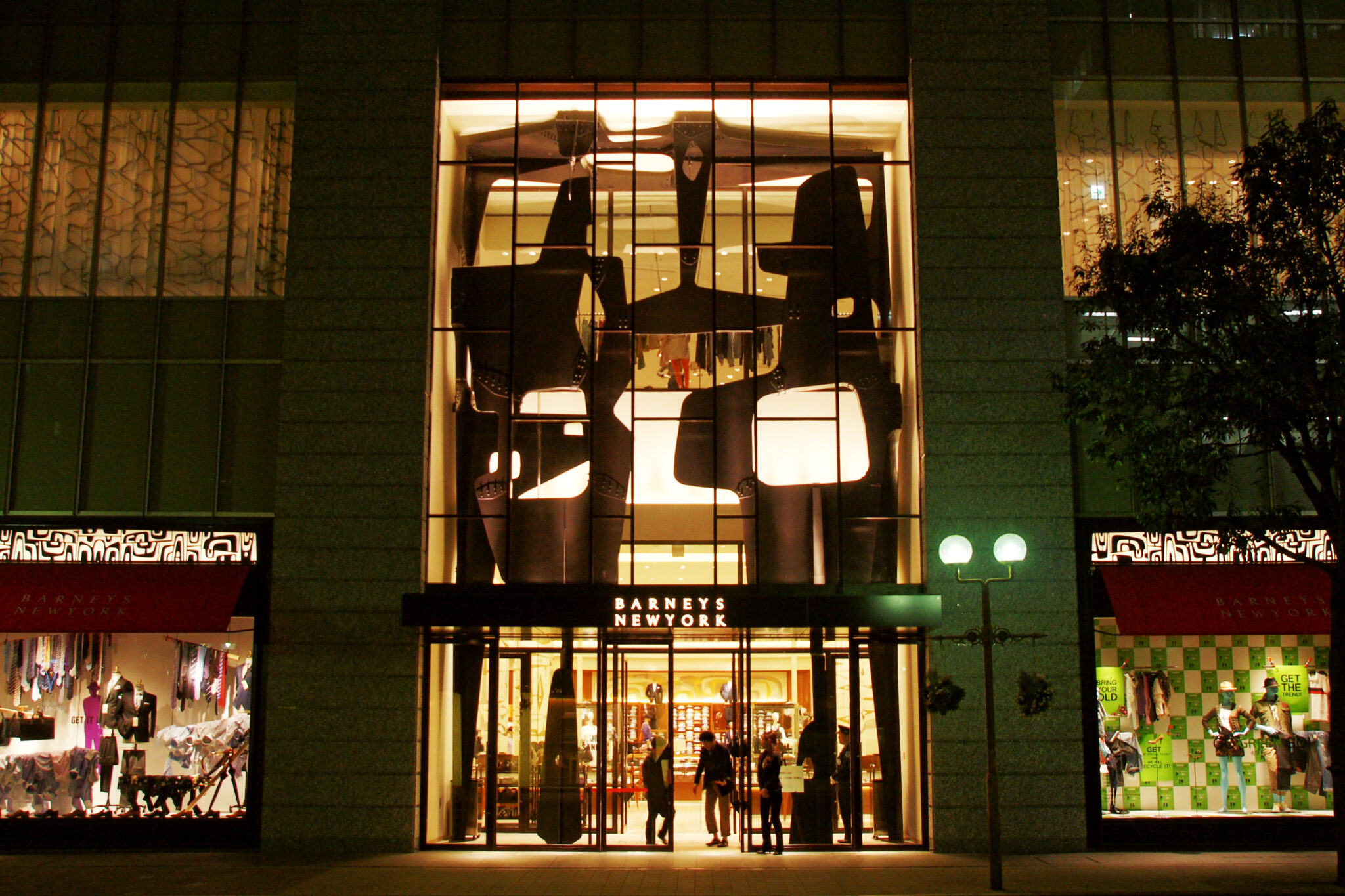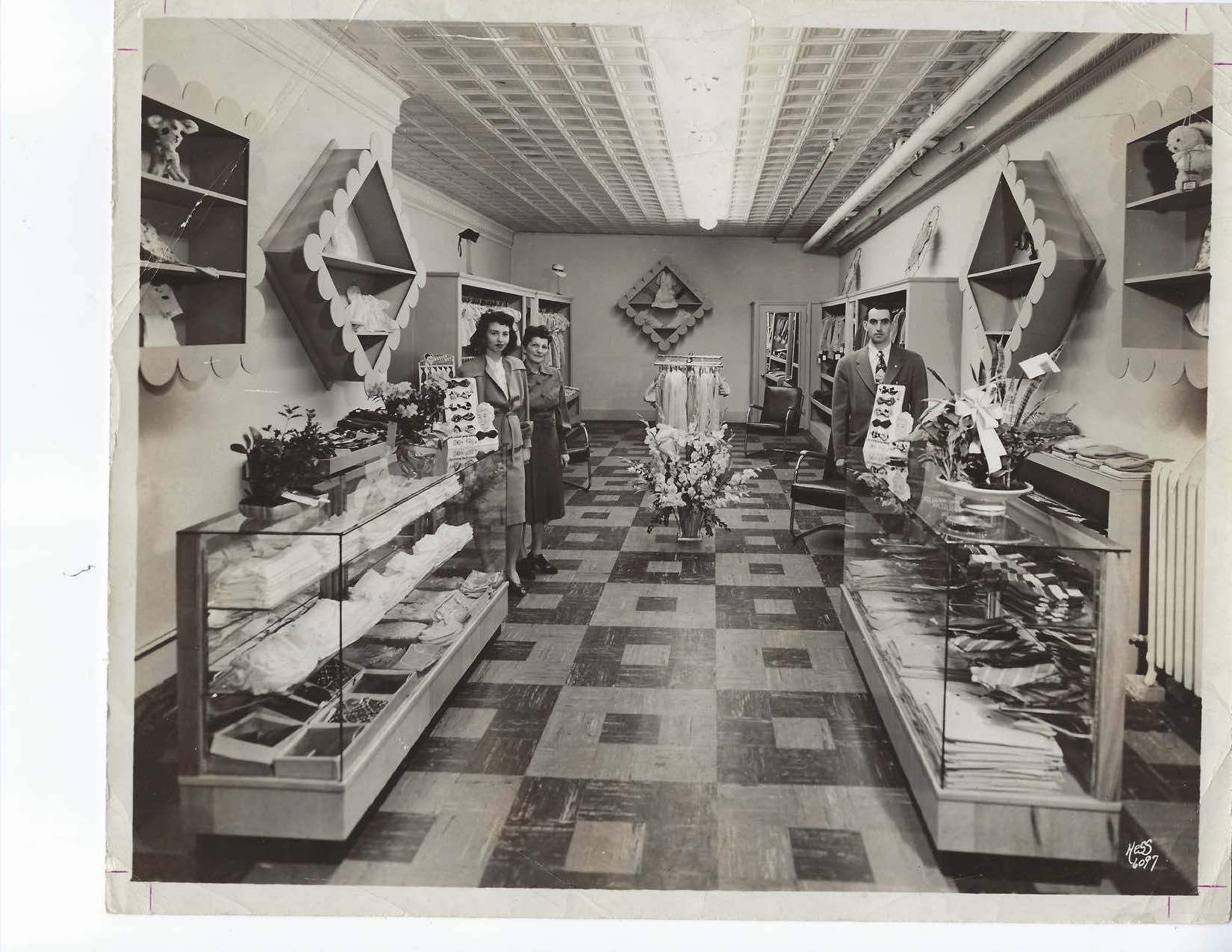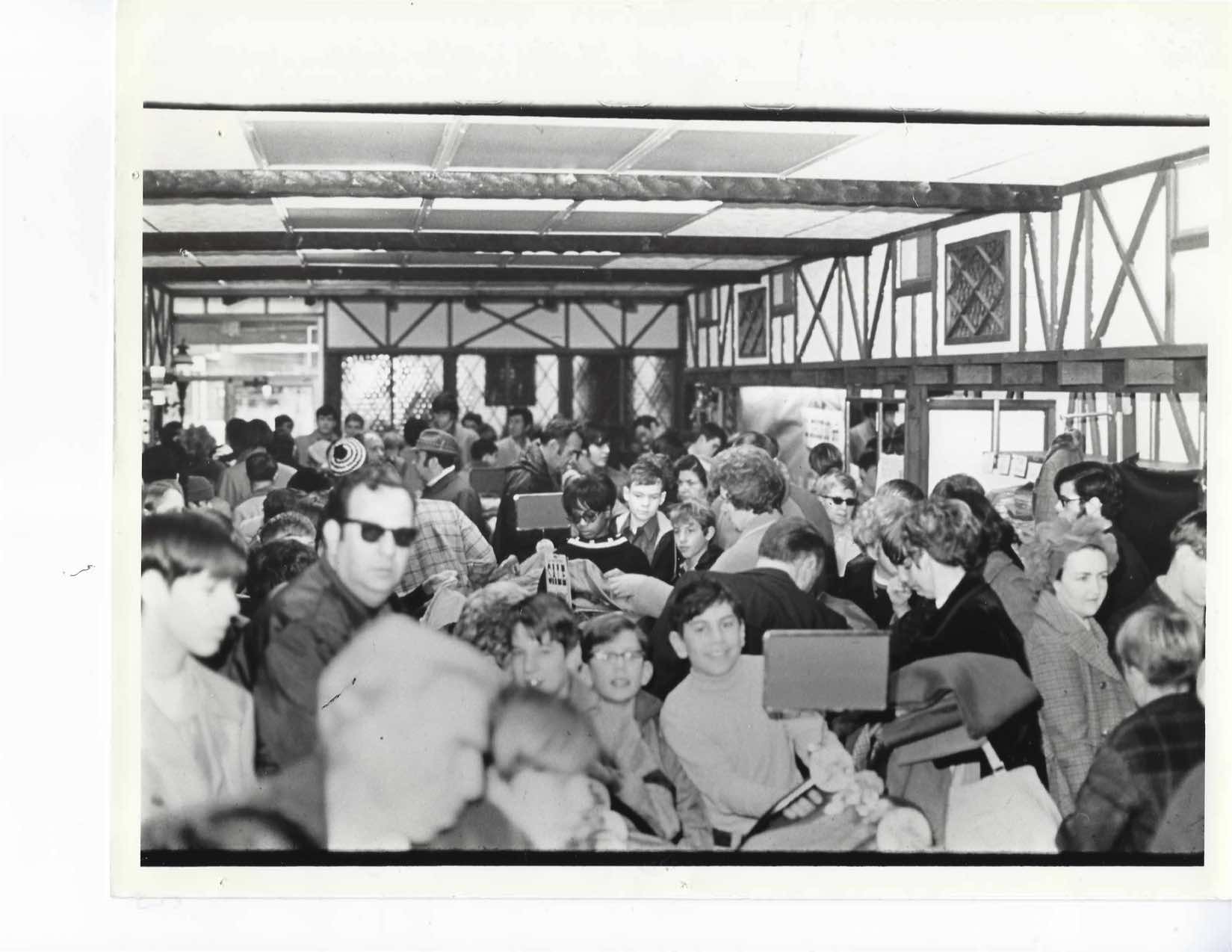
SPP Installation at Barneys, 2017. LICENSED UNDER CC0 1.0.
FLOOR LL
In 1923, Barney Pressman pawned his wife’s engagement ring for five hundred dollars and opened a five-hundred-square-foot clothing store on West Seventeenth Street and Seventh Avenue, in downtown Manhattan, where he sold well-tailored menswear at steep discounts. He hung a sign over the doorway: BUNK, NO JUNK, NO IMITATIONS. Abandon hope, all ye who enter here.
By the time Barney retired, in 1975, the store was doing $35 million per year in business. Barney’s son, Fred, added women’s wear, expanding the store into a row of town houses across the street. Under Fred’s leadership, Barney’s adopted a cool, upscale, whimsical vibe. Barney’s scaled up—it was the first place in America where you could buy Armani suits—yet maintained a patina of accessibility through its legendary warehouse sales, where you could find Norma Kamali sleeping-bag coats in wacky colors at whacked-down prices. In 1981 Barney’s became Barneys, discarding the apostrophe, becoming plural instead of possessive—the royal we.
In 1993, Barneys moved to a 230,000-square-foot French limestone palace on Madison Avenue and Sixty-First Street, becoming the largest new store built in New York City since the Great Depression. At the opening night party, Barneys spent a quarter of a million dollars on canapés. The Madison Avenue flagship boasted ten circles of hell, from floor LL to floor 9, home to the restaurant Freds. There were also secret floors: the mezzanine, a leatherbound couture clubhouse; the passage to the interior ballroom; the elevated jewelry section deep in the back of the first floor—beyond the Fendi baguettes and fur-covered pouchettes—where the real money began. Tourmaline, 20K gold, platinum-tinted locks.
The floors of Barneys form a fantasia in my mind, at once kaleidoscope and memory palace, a zoetrope that blurs my personal memories with something more collective. The department store represents a glittery, glamorous, starry life that seems impossibly out of reach, yet it is also embedded in my DNA; my grandparents owned one in Atlantic City, New Jersey. Department stores feel like a revolving door spinning constantly between who I am and who I imagine myself to be.
Floor LL—the Foundation—housed the Madison Avenue store’s cosmetics department: foundation, gold-leaf face cream in unbreakable jars, masks, brushes. It sold perfume—Frédéric Malle’s Portrait of a Lady, Serge Lutens, Dior. When I was in my mid-twenties, I bought a Le Labo scent, Thé Noir, that was compounded for me right in the store. While it was being distilled, I was able to design my own custom label. “The thé,” I wrote, after the ending of Wallace Stevens’s “The Man on the Dump”:
… Is it peace,
Is it a philosopher’s honeymoon, one finds
On the dump? Is it to sit among mattresses of the dead,
Bottles, pots, shoes and grass and murmur aptest eve:
Is it to hear the blatter of grackles and say
Invisible priest; is it to eject, to pull
The day to pieces and cry stanza my stone?
Where was it one first heard of the truth? The the.
WINDOWS

Barneys New York in Kobe, Japan. Licensed under CC0 1.0.
Department-store windows are a spectacle. When you look in the window, you don’t see into the storefront itself: you see a fashion-fantasia aquarium depicting a scene, like a diorama in a natural-history museum. Barneys’s longtime creative director, Simon Doonan, who joined the company as a window dresser in 1986, made the store’s windows iconically rebellious, a punk bizarrerie. Doonan put industrial tape on a nude statue of Madonna, spammed a rigorously minimalist Bottega Veneta mannequin display with dozens of Mr. Potato Head dolls, and dreamed up Dominatrix Margaret Thatcher.
Doonan’s flair marked him as the heir apparent to one of the pioneering show-window dressers of the early 1900s: L. Frank Baum. Emerald City, the glittering jewel of Baum’s Oz, is nothing if not a grand department store, one with shopwindows that are simply too dazzling for Dorothy’s unjaded sight to bear. “Many shops stood in the street, and Dorothy saw that everything in them was green,” Baum writes. “Green candy and green pop-corn were offered for sale, as well as green shoes, green hats, and green clothes of all sorts. … Everyone seemed happy and contented and prosperous..”
In addition to inventing Oz, Baum was also a pioneer in the then new art of creating elaborate shopwindows: his book on the subject, The Art of Decorating Dry Goods Windows and Interiors, was published at almost exactly the same time as The Wonderful Wizard of Oz. In 1900, a department store in Chicago advertised its new millinery collection using the “vanishing lady,” a technology that Baum popularized: the top half of the mannequin featured a hat, but the torso and legs periodically disappeared, reemerging in a new outfit. So many onlookers pressed against the glass to watch the lady’s bottom half vanish that the store had to reinforce the windows with iron bars to keep them from cracking.
FLOOR ONE
Inside, through the revolving door, past the velvet rope and the Armani-armed security guard, the first floor is Accessories. When you turn to the left, you find sunglasses staring back at you: aviators; oversize; cat-eyed; heart-shaped Lolita glasses. The lenses make up a wall of tiny convex mirrors in which you can see yourself reflected back, slightly distended, in amber and green gray and polarized jet black. Dorothy’s Emerald City is green because the Guardian of the Gate gives her green spectacles to wear: it’s she, not the city, that projects the fantasy. Once, at Barneys, I went to an Oliver Peoples trunk show by accident and emerged with a rose-tinted pair.
Past the sunglasses and to the right are the purses, poised along the angled, backlit shelves, or slouching languid and liquid. The warm mahogany paneling creates a buttery background so that the leather glows—rich, sheeny, dimensional. Tiny follicles stud the ostrich leather, a firmament of vacant quills. Crisp accordion folds hide in the upright rectangles; gleaming golden locks secure nothing. The bags are not only fantasies themselves, but in what they could contain.
In 1845, Henry W. Cross founded Mark Cross, a leather-goods store in Boston that sold exquisite saddles. By the century’s end, Mark Cross was located in New York, under new ownership, and sold a lifestyle, offering purses and apparel alongside fine crystals, cocktail shakers, and Scottish golf clubs. The heir to the Mark Cross brand, Gerald Murphy, married the noted socialite Sara Wiborg, and they hobnob-hopped between the Riviera and the Hamptons. Picasso painted Sara. Hitchcock, another friend of the couple, asked Murphy for a very specific bag that Grace Kelly would carry in the 1954 film Rear Window. On the outside, it’s nothing special—it resembles any box purse with clean lines—but Kelly opens it for the big reveal: it’s a cleverly designed overnighter, ready for a discreet rendezvous. It was later auctioned at Christie’s, in 2002, with a colorful description:
LOT 28: GRACE KELLY ‘MARK CROSS’ HANDBAG FROM “REAR WINDOW”
PARAMOUNT, 1954A black leather rectangular-shaped handbag used by Grace Kelly as she portrayed New York City girl-about-town and socialite, Lisa Carol Fremont, in the Alfred Hitchcock classic. Used throughout the extended scene when Kelly arrives to scandalously spend the night with Jeff, as portrayed by James Stewart…. Kelly calls it her ‘Mark Cross overnight case,’ Stewart asks if it’s really a suitcase, Kelly opens it to display a negligee as she coyly says “Preview of coming attractions,” Lieutenant Thomas J. Doyle, as portrayed by Wendell Corey, makes an innuendo about it and its purpose and lastly, Kelly naively asks if the Lieutenant thinks she’s stolen it. … The current consignor’s deceased mother won this handbag in a contest shortly after the movie was released in 1954, though the specifics are now not remembered by the family. 13 x 9 ½ x 3 inches.
Price realized: 5,019 USD
In this way, Grace as Lisa is Rear Window’s true window display. James Stewart’s Jeff might be looking out the window, but the fantasia aquarium is happening from within—Lisa highlights the Mark Cross bag as though she’s in a Barneys window. I can just imagine the Simon Doonan tableau: a riff on Botticelli’s Venus, with Lisa rising from the pale pink interior of a scallop. Lisa undoes the bag’s small gold clasp. The slim, hard, black-leather shell springs open, and the interior spills forth: a silk negligee, Botticelli slinky, in vulva pink, and matching satin slippers nestled on top.
The purse’s rosette burst is also the opposite of the garishly large zinnias cultivated by the murderer across the way from Jeff’s apartment. The negligee has been tucked in this rosette for hours, apparently, but when Grace Kelly emerges from the bathroom, it clings to her supple form with nary a wrinkle, maybe she’s born with it, no sign of age, so smooth that even crotchety Jeff is speechless. The negligee also has a capelet billowing out from around her shoulders. She never touches the floor.
In 2011, the once famous, then defunct handbag brand Mark Cross relaunched, phoenix luxe, returning to the same factories in Italy the company had always used. After the company’s revival, Mark Cross released the Grace Small Leather Box Bag, a new version of the overnight case. At Barneys, it sold in a rainbow of price points: navy blue, $2,395; python, $4,000; crocodile-stamped leather, $17,000.
FLOOR TWO
When Fred Pressman took over his father’s store in the late 1950s, he brought what Simon Doonan dubbed a “cognoscenti grooviness” to the brand. At a “Decorated Denim” fundraiser for aids relief in 1986, glitterati strutted down a staircase in Levi’s jackets custom-painted by artists such as Keith Haring and Jean-Michel Basquiat, which were then auctioned for charity. Andy Warhol modeled Barneys clothes in their print ads.
Barneys ads were better than any other department store ads. Glenn O’Brien—a writer known mostly for being Andy Warhol’s good friend and for being at the center of everything—gave Barneys’s print ads a David Hockney meets second generation New York School poets vibe, juxtaposing dry wit against smooth paintings in bright pastel tones. One ad shows a short-haired woman standing in front of a palm tree on a manicured lawn. Her eyes twitch down and to the left. Her lips are a shock of warm red. Her black silky jacket nips in at the natural waist and falls just below her hips, accentuating the curves of her wide-legged, impeccably white pants. Then, you notice the police car parked in the driveway. “Ruth had multiple personalities. They all had credit cards,” reads the copy. Next to Ruth’s waist: “Ruth is wearing jacket and pants by Jil Sander. Makeup by Look.”
One New Years’ Day, my ex-best friend and I were in Manhattan, avoiding being ourselves. We dressed Uptown cool-girl in sweaters and skinny jeans, our hangover makeup smudging our eyelids. She brushed her hair into gleaming with a lacquered brush that would have turned my curly hair into a beehive, then twisted her shiny locks into perfect disarray, anchoring the knot with a Bic pen. We walked up Madison and into Barneys and rode the endless glittering escalator—Escher Golden Barneys—stopping at every landing. Floor Two, designer women’s wear, was the only floor on the planet where everything, on this day of sales, was stubbornly full price. She plucked a pistachio-white leather jacket off the rack and handed it to me, where it glowed in my hands like ivory, butter smooth, illegal.
Miraculously, my card went through. That holiday season, Barneys had swapped its black bags for gold ones that said BARNEYS XO, and I carried the golden ticket around all night, lovingly swaddled in tissue paper that was fibrous enough to withstand heavy wind yet so fragile it could rip at the touch of a stray fingernail.
FLOOR THREE
“Two days earlier, nearly 11,000 English literature and modern-language professors had descended on midtown Manhattan for the start of the Modern Language Association’s annual conference, the place where intellectual superstars like Stanley Fish, Elaine Scarry and Kwame Anthony Appiah share hotel space with hundreds of desperate Ph.D.’s interviewing for a meager handful of jobs. The jittery orgy of power, insecurity and angst is the other academy’s answer to the Cannes Film Festival, except that as these strivers fan across the city between standing-room-only panels, instead of Anita Ekberg emerging from a fountain, they strain to catch a glimpse of aging Harvard nymph Marjorie Garber emerging from Barneys.”
—Tom McGeveran and Rebecca Traister, “The Droves of Academe,” The New York Observer, January 6, 2003
When I moved to Cambridge, Massachusetts, to start a Ph.D. program, my apartment was a third-floor walk-up studio, with a hallway bathroom that I shared with my eighty-two-year-old neighbor, who’d lived in her identical studio for decades. Dead bees would materialize in that apartment with some regularity: two or three falling out of the lampshade when I turned the bedside lamp on, another two on the kitchen-area linoleum, a handful under the radiator. An exterminator finally came; I vacated for a night, and when I came back, one wall had been ripped out, replaced by a tarp sagging with insect husks.
“Did you know,” the exterminator said, “that you had seventy thousand bees living in your walls?”
My closest physical Barneys was in Back Bay, Boston—just a couple of miles across the river, but you might as well have needed a passport. Boston Barneys was Bad Barneys. The store was bi-level, the first floor mid-century opulent, in teak that looked cheap but probably wasn’t, dresses displayed on the walls as though in a gallery. The second floor wasn’t quite right, either: too white and somehow both minimalist and punk. I used to buy things there with sale prices scrawled on the tags, spending too much money on what I didn’t really want, then walk back across the MIT bridge, which was 364.4 “smoots” long (the height of Oliver R. Smoot, a 1958 frat pledge, plus or minus one ear).
The decline and fall of the glamor of academia and the heyday of the department store are deeply intertwined: they are cultural bastions of elitism, with rites of passage that involve family hierarchies, new clothes, and the seasons, within which only a few rise to the top and certain departmental monoliths hold sway over the entire institution’s cultural and financial well-being. The CUNY Graduate Center had to inherit B. Altman’s old footprint: there was no other heir for this palatial shell.
To me, Barneys was another elite institution that beckoned me as it crumbled. Barneys was more than a department store: it symbolized what it meant to be a member of the elite. For my first piece of paid journalism, I’d rented a car to drive to the suburbs and visit an American Girl store, so that I could write about these dolls that were marketed not as the historical characters that had made the brand famous, but as mini-me avatars: you weren’t buying a piece of history, you were buying you. When the $250 check arrived, I had already, in true Sex and the City style, pegged what I imagined to be the most glamorous thing that exactly that amount of money could buy: a Barneys New York–brand cashmere sweater, long, emerald green, with quilted-leather cuffs, that I imagined as my writer’s uniform. I’ve never actually worn it; it’s attracted moths. But I know it’s there, waiting in the back of my dresser, a holey talisman of a dream version of myself.
FLOOR FOUR
When Barneys moved to its new Madison Avenue palace in 1993, the company abandoned its flagship storefront on Seventh and Seventeenth. The discount department-store chain Loehmann’s moved into part of that building; the Rubin Museum of Art took up residency in another. By 2014, Loehmann’s was defunct; by 2016, Barneys had moved back, opening Barneys Downtown in the original Chelsea location. (The Rubin stayed put, and the old-new Barneys grew around it, the way Broadway bumps around Tenth Avenue to make room for a cherry tree.)
The best bathrooms in Manhattan were in Barneys Downtown. They were individual rooms the size of studio apartments, industrial-steel gray with persistently white sinks, and great light. I’d dream of hanging out with the mannequins there after hours, drinking Johnnie Walker Black Label at the McKittrick Hotel, where we’d see that immersive version of Macbeth, called Sleep No More. We’d follow the Weird Sisters into the basement and go into the bathroom with Lady Macbeth as she washed blood over and over from her hands, to no avail.
Barneys Downtown was where I impulse bought a pair of em dash–shaped earrings. I paid $290, which was cheap, apparently, because they were sterling silver and not white gold. I have worn them nearly every day since, so, according to my calculations, after less than a year, they were paying me.
A glowing spiral staircase, white as milk, wound its way through the store—the Guggenheim, but make it fashion. Manolo Blahniks perched on metallic display stands bubbled up like filigreed fungi, their surfaces so lacquered that the stilettos mirrored themselves in the glass, the marble, and the gold.
That spiral staircase in Downtown Barneys was my DNA.
My grandfather, my grandmother, her sister, and her sister’s husband founded Gordon’s Alley, a small department store in Atlantic City that became the first pedestrian mall in that city. The business started as Gordon’s Youth Shop, a children’s clothing store, because my dad, his sister, and their cousins were babies. As the kids grew up, the store expanded to outfit them: Juniors and Teens, Menswear, Women’s Wear.
I never knew my grandparents’ department store—it closed when I was a baby. Barneys was Barneys but it was also connected somehow to Gordon’s Alley, which I felt attached to as though it were my own.
FLOOR FIVE
My favorite Barneys was a secret Barneys, the Barneys Co-op that existed on the Upper West Side for a tiny sliver of time. (They had to drop the Co-op from its name when the store got sued because it wasn’t really a co-op—it was just co-opting the idea to seem cool.) The store was entirely street-level, but as soon as you swirled in through the heavy crystal revolving door, you felt as though you were underground, in a futuristic wine cellar. The store was a single, infinite room, the walls pulsing bright white. Racks of clothes organized by designers—astral projections of aspirational life—shimmered as you approached and disappeared in your peripheral vision, hologram-thin. Isabel, Chloé, Alaïa, Rejina. I could be anyone.
When I was trying to escape myself in graduate school, I would invent reasons to go from Boston to New York. I once traveled four hours by train and twenty minutes by subway to take a fifteen-minute meeting, then floated west to Secret Barneys. A vest materialized before me, marled wool, Britomart meets Joan of Arc meets ski bunny. I bought it on the spot, then walked the forty blocks back to Penn Station because I didn’t have enough money on my Metrocard for the fare.
FLOOR SIX

Barneys New York in Scottsdale, Arizona. LICENSED UNDER CC0 1.0.
In the nineties and early aughts, Barneys tried to leave New York. Chicago, Boston, Dallas, Philadelphia: ultimately, all failed expansions.
At the Beverly Hills store, in June 2018, Barneys threw itself a party to launch “thedropLA,” an orgy of Barneys-exclusive collaborations. Each crossbred item got kissed with an “xo,” the Barneys equivalent of the red heart in I  NEW YORK. Manolo Blahnik, Fendi, Givenchy, Birkenstock, Dickies Construct, Cédric Charlier x Fruit of the Loom: Who in the fashion scene wasn’t Frenching Barneys?
NEW YORK. Manolo Blahnik, Fendi, Givenchy, Birkenstock, Dickies Construct, Cédric Charlier x Fruit of the Loom: Who in the fashion scene wasn’t Frenching Barneys?
The party sprawled over two days and five floors, attracting musicians, actresses, designers, influencers, and non-influencers with deep pockets. For the party’s crowning glory, Barneys installed a butterfly bar in its top-floor jewelry section, arranging gemstones among the fauna. The live butterflies became trompe l’oeil: each time a butterfly rested on a branch, it as appeared to be jewelry until it fluttered away. The luckiest guests might get one to perch on a wrist for an Instagram instant.
Not all the butterflies launched according to plan. According to People for the Ethical Treatment of Animals, dead and dying butterflies lay loosely around; others drifted outside, to unknown destinies. Barneys reported to peta that it would never again use live animals in a display.
Two years later, all the Barneys—Brooklyn, Boston, Chicago, Dallas, Los Angeles, Philadelphia, Seattle, New York, New York, New York, et cetera—were dead.
FLOOR SEVEN
Floors seven and eight were originally Barneys Co-op, but when the “Co-op” moniker had to go, they became a clunky penthouse suite they called “Contemporary,” which meant that it felt like it was cheaper because it was streetwear, even if the sweatpants were still hundreds of dollars. Barneys within Barneys. Contemporary was an abridged version of the rest of the store: Women’s, Men’s, Jewelry, Accessories, Shoes, all compressed into two floors. Genes @ Barneys was the contemporary café concept. I figured was because it was on the jeans floor—genius!—but it was actually named after Gene Pressman, a son of the original Barney. Gene was the Bad Barney: unlike Fred, who streamlined the Barneys zeitgeist, he led the charge to expand the brand, diluting the very air of inaccessibility that had made it cool.
The contemporary floors were a place I could pretend I was a version of myself who shopped at the real Barneys. I found a tennis-ball chartreuse Proenza Schouler satchel on such deep markdown that I couldn’t afford not to get it. When the herbalist I’d been kissing that summer invited me to his apartment in deep Brooklyn, I wasn’t sure what was going to happen, but the satchel was small enough to look like a purse and big enough to hold my glasses, a toothbrush, and a change of underwear. The apartment was a seven-story walk-up, but he had pocket doors, and there were thousands of his herbal tinctures in perfect diamond bottles winking in the built-ins. He had roof access, and we started there. It was a hot night. I lost a chip of a tooth and my virginity.
FLOOR EIGHT
Cronos, the ancient Greek Titan, had heard the prophecy: he would be overthrown by his own child. Each time Rhea, his wife, gave birth, he promptly swallowed the swaddled baby, reasoning that it could not undo him from within. Rhea obediently handed over the first five children, but when she had her sixth child, she smuggled an omphalos—a stone—into the swaddling clothes for Cronos to swallow instead. She hid the baby, Zeus, who eventually did grow up, overthrow his father, retrieve his five siblings from Cronos’s stomach, and appoint them as his corulers on Mount Olympus, the glittering palace of these new gods.
Saks Fifth Avenue sucked up the liquidated Barneys as though a milkshake through a straw .In November 2019, Saks partnered with the brand management company Authentic Brands Group to acquire Barneys for $271 million. As part of the deal, Saks sold Barneys’s back inventory during the 2019–2020 holiday season, but then rebooted Barneys as a mise en abyme : the department store had become a department within another department store. Unlike Barneys, which both rose and flamed out because of its coolness, Saks was aspirational without attempting to be ineffable. Barneys belonged to the stars and the start-ups; Saks relied on its reliability, and on aspiration without losing accessibility.
By January 2021, floor five at the Saks Fifth Avenue flagship had been reborn as Barneys “at” Saks, complete with Barneys-branded tote bags. It felt like the bad twin of Secret Barneys: all on one white, gleaming, but somehow smudged floor, all the guts splayed out in the open; no illusion, nothing special going on here anymore.
I wish Barneys hadn’t been swallowed by Saks. I wish Barneys would disappear completely, so that it could rise again, in mirroring glory. Who am I but the version of myself surrounded by seventy thousand bees dying in my lamplight?
In And Just Like That…, the 2021 reboot of Sex and the City, Barneys has shuttered but is still present. In one of the series’s best and most poignant sight gags, Carrie carefully pulls the box containing Mr. Big’s ashes from the back of her shoe collection, smooths out a wrinkled old Barneys New York shopping bag, and places Mr. Big inside.
FLOOR NINE
In January 2020, I made a pilgrimage to the flagship before it sank. Good buys, then goodbyes.
LL was done; the escalators didn’t go down there.
First floor: junky sunglasses, twenty of the same Valentinos with blood-red lenses.
There was this little handbag that looked like a tissue box—navy nacre with a shell-pink handle, ivory silk inset. It was lovely. I turned it over in my hands, wondering if I should buy it, and started carrying it across the floor to feel as though it were mine.
I carried it to floor two, where a little clique of headless mannequins blocked off access. Avant-garde, first to go.
The fur salon on third was as dead as ever. You could stroke the minks.
Fourth floor: menswear, no one cared.
Fifth floor: shoes, the Versailles mirrors peeled to the plywood. Two left-foot shearling stilettos in 40 ½ European size were strewn across the fungal shag carpet that had sprung up in the last few weeks, like an unkempt beard.
Sixth floor: contemporary, Tomorrowland, denuded.
On seventh I saw my nacre purse, again, and then in reverse coloration, a shell-pink box with navy trim. The more times I saw it the more it became the kind of tissue box you’d find in the best Barneys bathroom, the kind someone else had refilled with actual Kleenex. My winter-chapped knuckles were apparently bleeding—there was blood on the bag. I left it for the sharks.
Eighth floor: the table in the changing room was on sale and so was the three-way mirror, but the jeans were not. The women on eighth had been waiting weeks for the only macramé shawl. Somehow the walls had gone white to gray in days; they’d been secretly dyed the whole time. Please, Gott, I am an elderly woman, said a woman at the counter. Have mercy.
On ninth, Freds was still reservation only, with lacquered wood, hushed lighting. Only the restaurant was an aquarium. The rest was blasted out. Outside the dining room, the china was for sale.
Adrienne Raphel is the author of Thinking Inside the Box: Adventures with Crosswords and the Puzzling People Who Can’t Live Without Them. Her latest collection of poetry, Our Dark Academia, is forthcoming from Rescue Press in fall 2022. Her poem “Felix by Proxy” appears in the Spring issue of The Paris Review.




